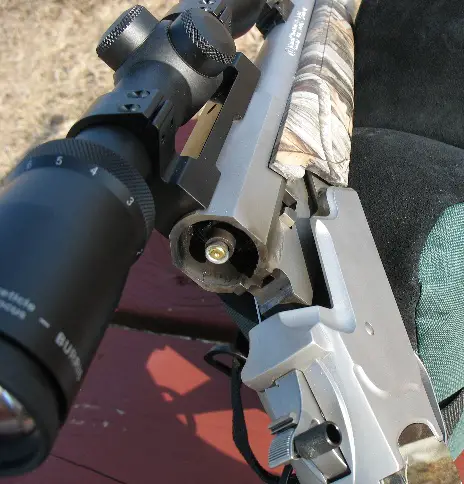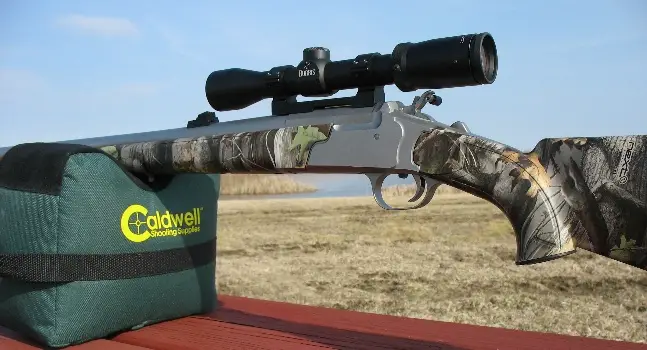


Knight KP1 Utility Rifle Review
The tested gun
is Knight’s long-awaited break-action KP1 Utility Rifle in .50 caliber
muzzleloading configuration with stainless steel barreled action and a
camo composite stock. As supplied, including the ramrod, the KP1 weighs
in at 8 pounds, 11 ounces according to my Lyman digital scale. As the
name suggests, this rifle features an interchangeable barrel system that
makes it easy to convert from muzzleloading to both centerfire and rimfire
metallic cartridges.
This is a huge departure for Knight Rifles, long a dedicated inline muzzleloading company, as it now allows Knight access to the centerfire and rimfire firearm marketplaces. The rifle itself has an interesting parentage, based in part on the “Wurfflein breech loading Rifle” manufactured in the late 1800s by William Wurfflien out of Philadelphia, Pennsylvania with a patent date of June 24, 1884. It was, and is, an extremely clean-looking action with eye-catching lines.
The supplied KP1 has an extremely good trigger, breaking crisply and cleanly at about 3 pounds, 10.5 ounces on the trigger gauge after its initial free travel, with no sand or grit. This is lighter than many out of the box triggers, particularly those found on muzzleloaders.
Several features of the KP1 make it very appealing. Forearm removal is accomplished with the push of a button, as is removal of the trigger group. A barrel change is little more than popping off the forearm, knocking out a hinge pin, pinning your centerfire barrel in place and sliding on the matching forearm. It is that easy; few rifles compare to this level of streamlined convenience.
Ironically, the muzzleloading barrel itself presents a couple of issues; ironic, as the history of Knight is the history of modern inline muzzleloading. The KP1 comes with two breechplugs: one for “full red plastic jacket” 209 primer use and the other for 209 shotshell primers alone. While the Knight red plastic jacket served an evolutionary use in pull-cock (Wolverine) and bolt action (Extreme, Disc Elite) rifles by partially addressing the scope-burning and action fouling propensities of 209 primers, its implementation in the KP1 is a disaster. To operate your KP1 in “red plastic jacket” mode, you first prepare your red plastic jackets by pushing them onto 209 primers. Now, the primed red plastic jacket is pushed onto the breechplug nipple. Problem is, on my test gun, the action does not close smoothly because the plastic jacket interferes with its snapping shut. After a few attempts and a little fiddling, the gun closes. After firing, the extractor that is part of the .50 caliber muzzleloading barrel does not properly extract the spent red plastic jacket, leaving the hapless shooter to attempt to fish it out. Not a particularly easy task with naked hands, it becomes an arduous task with gloved hands.
Even more bothersome is the great lengths traveled to include the red plastic jacket breechplug in the first place. To include the extractor that does not extract, we have the additional machining of a notch in the bottom of the barrel to accommodate it and a spring with retaining ears in the barrel to attempt to operate it. This strikes me as a tremendous waste of machining cost and effort. The red plastic jacket is a dumb idea as implemented in the KP1.
Fortunately, Knight includes a non-red plastic breechplug as well. Installing this breechplug solves the issue. The extractor must be removed to remove the red plastic jacket breechplug for cleaning and to install the standard 209 breechplug. Remove the extractor, put it in your "spare gun parts" box (unless you want to use the little flat-tipped screwdriver at the end of it), remove the red plastic jacket breechplug and put it with the extractor. Drop the red plastic jackets supplied with the gun in the wastebasket; at least you won’t have to worry about buying more of them.

This takes care of it, leaving you with the spring and retainer ears that were supposed to operate the extractor in the barrel doing nothing, which is close to what they did anyway. All is well, except that now you have a large gaping channel in the bottom of the barrel where the extractor we just removed used to be, a channel that serves only as a repository for crud and blowback particulate matter. All of this costly nonsense could have been avoided at the factory by forgetting about the extractor attempt, thus eliminating the extractor pushing spring, retaining ears and the channel in the bottom of the barrel.
After installing the standard 209 breechplug, the operating issues are now gone. The standard 209 breechplug has a .031 in. flash hole, a domed face and is magnetic at the primer end, smoothly retaining the primer prior to when you snap the gun closed. Now, the gun closes effortlessly and positively, with no extraneous plastic in the way to interfere. After firing over 50 shots in succession with the "naked" 209 breechplug, there was no hint of any external blowback on the scope or in the receiver / barrel joining area. Knight should lose the red plastic jacket nonsense in the KP1 as soon as possible; it would improve the gun right out of the box and it can’t happen too soon.
It has been suggested that the red plastic jacket somehow “weatherproofs” the action. This is a ridiculous notion, as applied to the KP1. The red plastic jacket has nothing to do with the action and can hardly weatherproof it. To see how sensitive 209 shotshell primers really are to moisture, I completely submerged a dozen Winchester W209 shotshell primers in the bottom of a glass of water for over an hour. Fishing them out, still dripping, I popped them one at a time into an otherwise empty Knight KRB. Guess what? They all went bang with no hesitation whatsoever. I am not suggesting that this is the proper way to store or use 209 primers, but the notion that they are all of a sudden extremely moisture sensitive is silly.
The KP1 action is hardly waterproof; a quick look at the action shows a tang button (not weatherproof) used to open the action and the complete trigger group (not weatherproof) that is quickly removed by sliding a little wedge forward. These are the primary components of the action and a red plastic primer holder is no where remotely connected to them. When hunting in extremely foul weather, the obvious migration path of rain water into the rifle is the muzzle. This potential issue is easily addressed by slipping a balloon, condom, or finger cot over it, solving the issue today as it has for decades. Keeping your muzzle pointed to the ground works, as well.
I installed the Knight / Talley integral scope base and rings: beautifully machined and ultra-light weight, they are well suited to this rifle and action. The Knight part number is 900778, the call-out is “Knight Talley Rings High.” Wanting to scope the KP-1 with good glass that was appropriate for the action, I used one of my favorite muzzleloading scopes (really, a great scope for any big game hunting rifle) a Burris Fullfield II 2-7x35mm Ballistic Plex. It looks great on the KP1, though even with what Knight calls “high” rings leaves scant little room between the hammer and the eye-bell of the Burris. Those who want bulkier outside dimension scopes might want to check with Knight for their other base options. I am very pleased with this specific set-up.
This brings us along to another strange “feature” of the KP1: the “decocking safety.” The KP1 has an integral transfer bar safety that is more than adequate to begin with. However, this odd “decocking safety” was added in the form of a little flipper that resides on top of the hammer itself. Apparently, the theory is that you should (after cocking the KP1, but then deciding not to fire it) flip the decocking safety forward, which allows the little button striker in the face of the hammer to retract, then uncock your gun by pulling the trigger and lowering the hammer with your thumb. In the event your thumb slips off the hammer while decocking, the decocking safety is supposed prevent discharge.
At the same time, after describing this little oddity, Knight warns in the manual: “Do not allow the hammer to snap forward.” This should cause reasonable people to wonder why the flipper exists at all. You must go through great contortions to use it, as it is very hard to get to on a scoped rifle. (The hammer itself cannot be easily cocked without the included hammer extension.) The only purpose the decocking safety could reasonably serve (dry firing the rifle) is specifically prohibited. The decocking safety is another “feature” of this rifle that serves no purpose. This offends my delicate sensibilities.
I am very concerned about firearms safety, particularly muzzleloading safety, and have been for many years. Handling 209 primed muzzleloaders is straightforward: if a muzzleloader is to leave your direct control for any reason, the 209 primer is removed. The KP1, in particular, is a very easy firearm to render inert. A push of the tang button, the action falls open; it is just that easy. Snap it closed and you are good to go again. The integral transfer bar safety is in addition to normal, prudent, gun handling and, as mentioned, is more than adequate for the job. Struggling with a needless “decocker” serves no purpose. My decocker is set to the rear (“F”) position forever and under no circumstances would I walk around with a muzzleloader with the hammer pulled back. In any case, this is a confusing bit of extraneous gimmickry that should be eliminated from the KP1. On a more positive note, the “decocker” in no way impedes or affects the operation of the rifle.
There seems to have been some sort of competition in recent years to see who can build the ugliest, most repulsive muzzleloader. I am glad to report that this is not the case with the KP1; it has dashing good looks compared to many muzzleloaders; it is far easier on the eye than most, including most break-actions.
Knight has always done well in the composite stock department. Knight stocks are generally better than most of the hollow Tupperware examples out there and the composite stock on the KP1 is no exception. To an attractive camo pattern, the KP1 adds a well-fitted Kick-Eez recoil pad, long one of my favorite pads. Not only is the KP1 a handsome rifle, but it sports very good, practically neutral balance. It is one of the best handling muzzleloaders to be introduced in some time.
At the range, I had little trouble getting the KP1 to shoot right at 1-1/4 inch 105 yard groups using Barnes TMZ 290 sabots over 100 grains by volume of Blackhorn 209 with no swabbing between shots. This is more accuracy than you can use on a big game animal, or at least more accuracy than I can use. The KP1 is also comfortable to shoot, owing much of that to the stock design along with the Kick-Eez pad. I can think of several muzzleloaders that would have you begging for mercy after a dozen rounds of this load, but 72 shots (three Barnes 24-packs) of the TMZ 290s left me no worse for wear.
Despite the cited caveats, I’m impressed to say the least with Knight’s KP1. It is the best looking, easiest to use, best handling, best performing break-action muzzleloader on the market today. It has the potential to be greater still.
I would be negligent
if I didn’t explore the versatility of this rifle; after all, it
is a “utility rifle.” To that end, expect a full review of the
KP1 in .270 Winchester centerfire configuration in the very near future.
Copyright 2008 by Randy Wakeman. All Rights Reserved.

Custom Search




